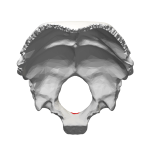Foramen magnum
The foramen magnum (Latin: great hole) is a large oval opening (foramen) in the occipital bone of the skull in humans and various other animals. It is one of the several oval or circular openings (foramina) in the base of the skull. The spinal cord, an extension of the medulla, passes through the foramen magnum as it exits the cranial cavity. Apart from the transmission of the medulla oblongata and its membranes, the foramen magnum transmits the vertebral arteries, the anterior and posterior spinal arteries, the tectorial membranes and alar ligaments. It also transmits the spinal component of the accessory nerve into the skull.
The opisthion is the midpoint on the posterior margin of the foramen magnum and is a cephalometric landmark. Another landmark is the basion located at the midpoint on the anterior margin of the foramen magnum.
The foramen magnum is a very important feature in bipedal mammals. One of the attributes of a bipedal animal’s foramen magnum is a forward shift of the anterior border; this is caused by the shortening of the cranial base. Studies on the foramen magnum position have shown a connection to the functional influences of both posture and locomotion. The forward shift of the foramen magnum is apparent in bipedal hominins, including modern humans, Australopithecus africanus, and Paranthropus boisei. This common feature of bipedal hominins is the driving argument used by Michel Brunet that Sahelanthropus tchadensis was also bipedal, and may be the earliest known bipedal ape. The discovery of this feature has given scientists another form of identifying bipedal mammals.
[1]
Other animals
In humans, the foramen magnum is farther underneath the head than in the other great apes. Thus, in humans, the neck muscles (including the occipitofrontalis muscle) do not need to be as robust in order to hold the head upright. Comparisons of the position of the foramen magnum in early hominid species are useful to determine how comfortable a particular species was when walking on two limbs (bipedalism) rather than four (quadrupedalism).
Additional images
| Skull seen from below. The hole through which the medulla (shown in red) is passing is foramen magnum. |
| Human brain with dura mater intact. The foramen magnum is visible as the large hole in the centre. |
| Occipital bone inner surface (basion shown in red) |
|
See also
References
This article incorporates text in the public domain from the 20th edition of Gray's Anatomy (1918)
External links





